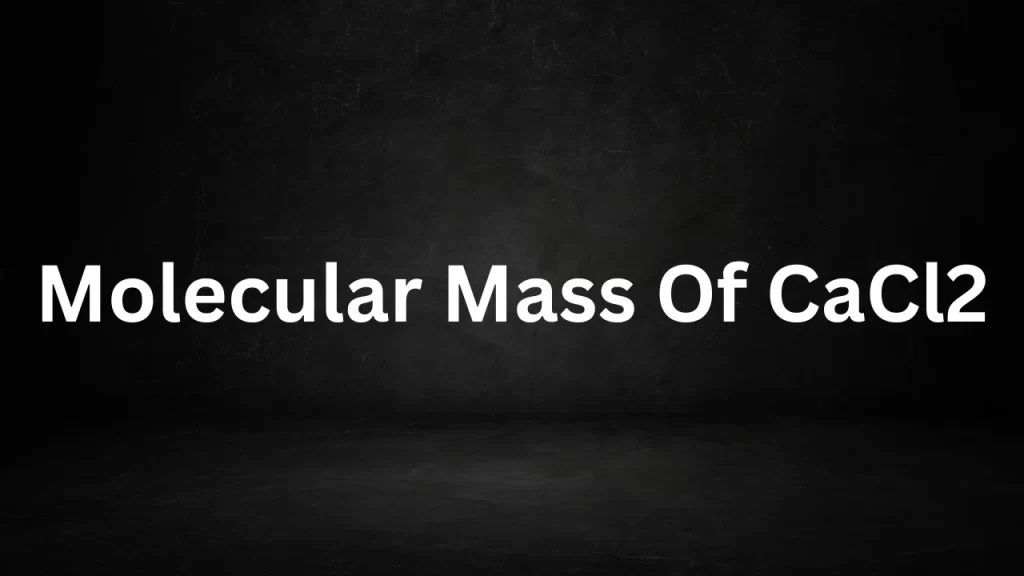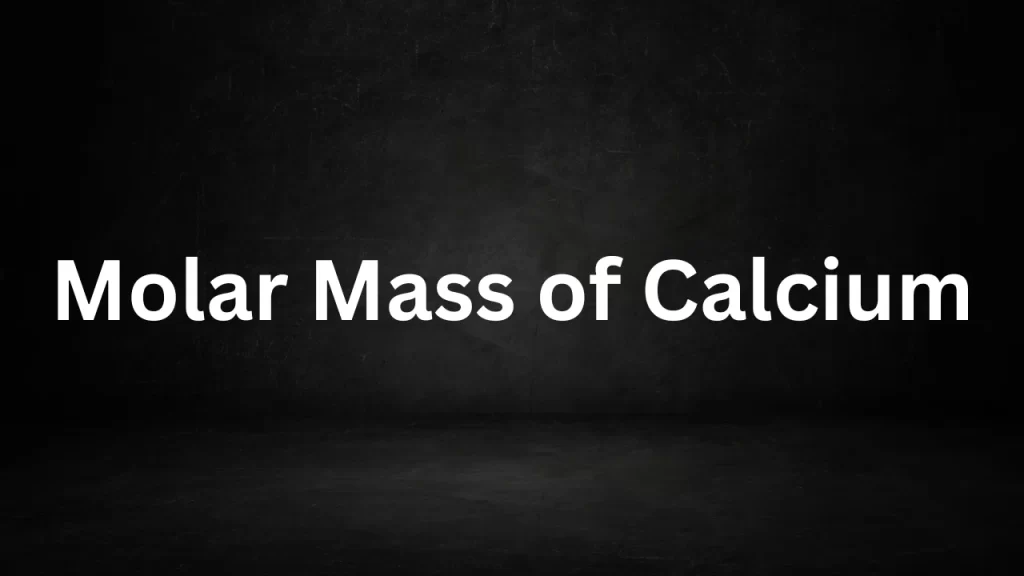Tag: molecular mass of cacl2
Molecular Mass Of CaCl2
Molecular Mass Of CaCl2: Calcium chloride (CaCl2) is a chemical compound that plays a significant role in various industrial, scientific, and everyday applications. To understand its properties and behaviors in chemical reactions, it’s essential to explore its molecular mass.
In this article, we will delve into the world of calcium chloride’s molecular mass, its significance, and practical applications.

Molecular Mass Of CaCl2
The Chemical Formula of Calcium Chloride
Before discussing the molecular mass, let’s establish the chemical formula for calcium chloride. Calcium chloride is composed of one calcium (Ca) atom and two chlorine (Cl) atoms, making its chemical formula CaCl2. This formula indicates the relative proportions of each element in the compound.
Atomic Structure of Calcium and Chlorine
To understand calcium chloride’s molecular mass, we must account for the atomic masses of calcium (Ca) and chlorine (Cl). Calcium possesses an atomic number of 20 and an atomic mass of approximately 40.08 amu. Chlorine, having an atomic number of 17, has an atomic mass of around 35.45 amu. It’s important to note that these atomic masses are averages that consider the naturally occurring isotopes of each element.
Molecular Mass of Calcium Chloride (CaCl2)
To calculate the molecular mass of calcium chloride (CaCl2), we add the atomic masses of each element present in the compound:
Molecular Mass of CaCl2 = (Atomic Mass of Ca) + (2 x Atomic Mass of Cl) Molecular Mass of CaCl2 = (40.08 amu) + (2 x 35.45 amu) Molecular Mass of CaCl2 = 40.08 amu + 70.90 amu Molecular Mass of CaCl2 = 110.98 amu
So, the molecular mass of calcium chloride (CaCl2) is approximately 110.98 atomic mass units (amu).
Significance of Molecular Mass
Understanding the molecular mass of calcium chloride is essential for various reasons:
- Stoichiometry: Molecular mass plays a critical role in stoichiometric calculations, helping chemists determine the quantities of reactants and products in chemical reactions involving calcium chloride.
- Formulation and Manufacturing: Industries use calcium chloride in various formulations and manufacturing processes, where the precise measurement of its molecular mass ensures accurate ingredient proportions.
- Analytical Chemistry: In analytical chemistry, molecular mass is crucial for identifying and quantifying calcium chloride in samples, facilitating quality control and research.
- De-icing and Dust Control: Calcium chloride is widely used for de-icing roads and controlling dust on unpaved surfaces. Understanding its molecular mass is crucial for calculating the appropriate application rates.
Conclusion
The mole mass of calcium chloride, about 110.98 amu, is a fundamental and significant concept in the realms of chemistry and industry. and research. It facilitates accurate measurements in chemical reactions, quality control, and various applications where calcium chloride plays a pivotal role. A clear understanding of its molecular mass is essential for harnessing the compound’s diverse capabilities in our modern world.
Read More
- Molecular Mass Of Mg
- Molecular Mass Of Iodine
- Molecular Mass Of Sugar
- Molecular Mass Of Copper
- Molecular Mass Of Cl2
Frequently Asked Questions (FAQs) On Molecular Mass Of CaCl2
1. What is the molecular mass of calcium chloride (CaCl2)?
The mole mass of calcium chloride (CaCl2) is approximately 110.98 atomic mass units (amu).
2. How is the molecular mass of calcium chloride calculated?
The mole mass of CaCl2 is determined by adding the atomic masses of its constituent elements: calcium (Ca) and chlorine (Cl). For CaCl2, you add the atomic mass of Ca to two times the atomic mass of Cl.
3. Why is the molecular mass of calcium chloride important in chemistry?
The molecular mass is crucial for stoichiometry and helps chemists calculate the amounts of reactants and products in chemical reactions involving calcium chloride.
4. What are the atomic masses of calcium (Ca) and chlorine (Cl)?
The atomic mass of calcium (Ca) is approximately 40.08 amu, while the atomic mass of chlorine (Cl) is around 35.45 amu.
5. Are there any common uses of calcium chloride in everyday life?
Yes, calcium chloride is used for various purposes, including as a de-icing agent for roads in winter, a desiccant to absorb moisture, and in food processing, particularly in cheese making.
Molar Mass of Calcium
Molar Mass of Calcium: Calcium is an element that plays a pivotal role in various aspects of our lives, from maintaining healthy bones and teeth to its widespread use in industrial applications.
In this article, we will explore the molar mass of calcium (Ca) and delve into its significance in the realm of chemistry.

Molar Mass of Calcium
The Importance of Calcium
Calcium is a chemical element with the atomic number 20 and the symbol Ca. It is an essential nutrient for living organisms, including humans. In our bodies, calcium is primarily found in our bones and teeth, where it provides structural support and strength. Beyond its biological importance, calcium also has significant industrial applications, making it a valuable element in many industries.
Atomic Structure of Calcium
To understand the molar mass of calcium, we need to explore its atomic structure. A calcium atom contains 20 electrons, arranged in four energy levels or electron shells. The electron configuration of calcium is 2-8-8-2, indicating that it has two electrons in the first shell, eight electrons in the second and third shells, and two electrons in the fourth shell. The outermost shell, with its two electrons, is known as the valence shell.
Calcium’s atomic number, 20, signifies that it has 20 protons in its nucleus, giving it a positive charge. To maintain electrical neutrality, calcium also has 20 electrons. In addition to protons and electrons, the nucleus of a calcium atom contains 20 neutrons, which are electrically neutral particles with a mass similar to that of protons.
Molar Mass of Calcium
The molar mass of an element is defined as the mass of one mole of atoms of that element, expressed in grams per mole (g/mol). It is a fundamental concept in chemistry, as it enables chemists to link the mass of a substance to the number of atoms or molecules it contains.
To calculate the molar mass of calcium, we consider the contribution of its isotopes. Calcium has several isotopes, with calcium-40 being the most abundant, followed by calcium-44, calcium-42, and a few others. The molar mass of calcium is determined by taking a weighted average of the masses of these isotopes, using their natural abundance as the weighting factor:
Molar Mass of Calcium (Ca) = (Fractional Abundance of Ca-40 × Mass of Ca-40) + (Fractional Abundance of Ca-44 × Mass of Ca-44) + …
In practice, the calculation considers all isotopes and their abundances, resulting in the molar mass of approximately 40.08 g/mol for calcium.
The Significance of Molar Mass
The molar mass of calcium is a critical value in chemistry, serving as a cornerstone for various chemical calculations. It is indispensable in determining the amount of calcium required for specific chemical reactions, stoichiometry calculations, and the formulation of chemical equations. In industries such as metallurgy, agriculture, and construction, knowing the molar mass of calcium is vital for precise measurements and formulations.
In conclusion, the molar mass of calcium, approximately 40.08 g/mol, underlines the importance of this element in both biological and industrial contexts. Its role in maintaining our health and contributing to technological advancements makes understanding its atomic properties and molar mass an essential part of our scientific knowledge.
Read More
- Electromagnetic Spectrum X Rays
- Electric Circuit Electrical Symbols
- Difference Between Watts And Volts
- Molar Mass Of Sulphur
- Electronics In Daily Life
Frequently Asked Questions (FAQs) Molar Mass of Calcium
Q1: What is the mol mass of calcium?
A1: The mol mass of calcium (Ca) is approximately 40.08 grams per mole (g/mol).
Q2: Why is the mol mass of calcium important in chemistry?
A2: The mol mass of calcium is crucial in chemistry because it allows chemists to relate the mass of calcium atoms or molecules to the number of atoms or molecules present. This value is fundamental for stoichiometry calculations, chemical equations, and precise measurements in various industries.
Q3: How is the molar mass of calcium calculated?
A3: The mol mass of calcium is calculated by taking a weighted average of the masses of its isotopes, considering their natural abundances as weighting factors. Calcium has several isotopes, with calcium-40 being the most abundant. The calculation accounts for all isotopes and their abundances.
Q4: What are the main applications of calcium in industry and daily life?
A4: Calcium has numerous applications, including:
- In daily life: It is essential for the formation and maintenance of healthy bones and teeth.
- In agriculture: Calcium is used as a soil conditioner and in fertilizers to enhance plant growth.
- In construction: Calcium is used in the production of cement and concrete.
- In metallurgy: Calcium is employed to extract various metals from their ores.
- In the food industry: Calcium is added as a dietary supplement and preservative.
Q5: Are there any health implications associated with calcium’s molar mass?
A5: Calcium’s molar mass itself doesn’t have direct health implications. However, maintaining an adequate intake of calcium through diet or supplements is important for overall health, particularly for bone health, muscle function, and nerve signaling.